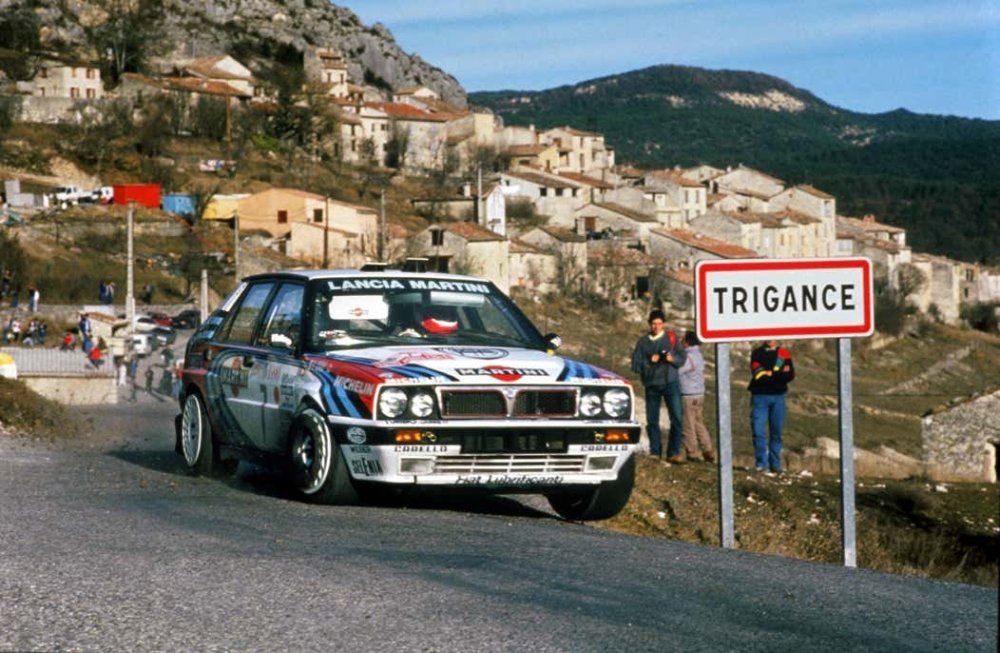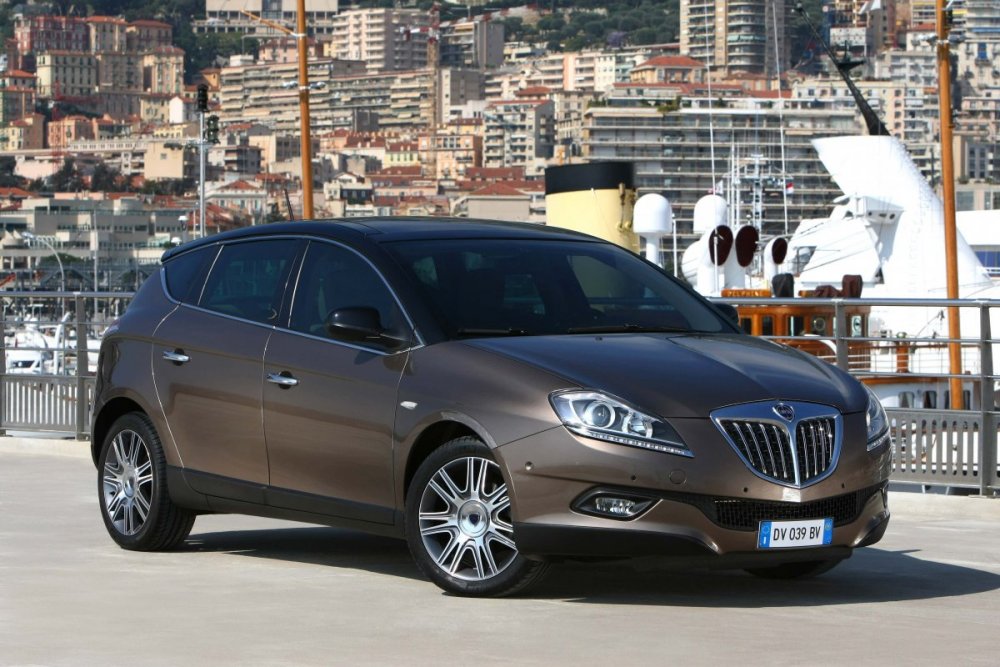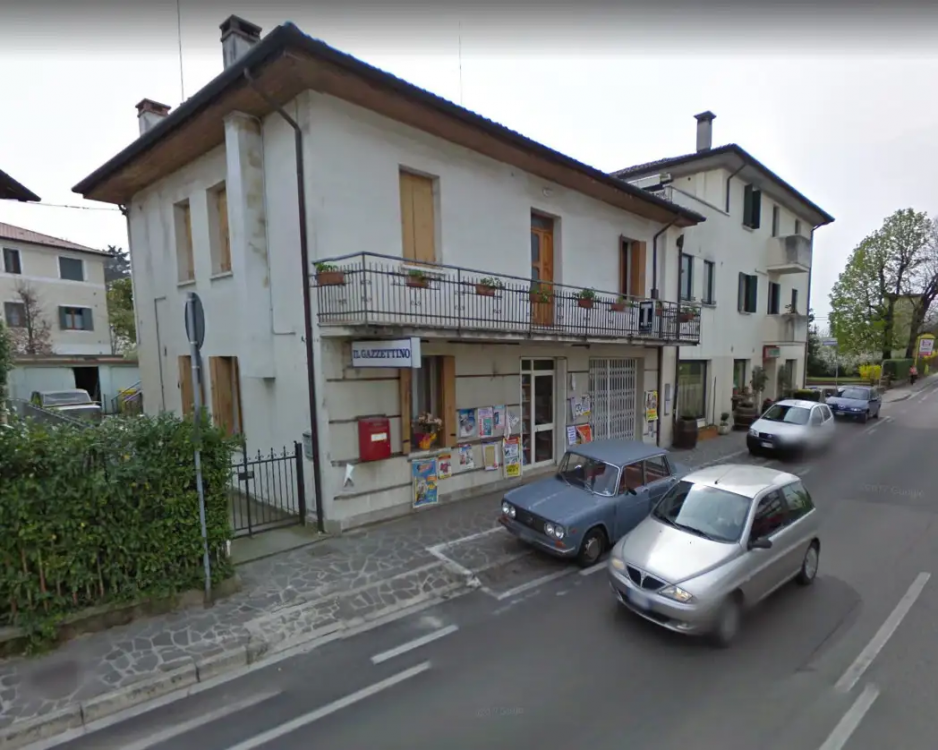Search the Community
Showing results for tags 'lancia'.
-

Lancia returns to rallying with an electric Delta Integrale
enzoalec92 posted a topic in Motorsports
<A 670-HP Lancia Delta Integrale EV Will Tackle World Rallycross in 2022 With the FIA's WRX series going electric, now's the time to revive a true classic. Ahh, rallycross going electric. It feels like someone invents a new version of it every week, probably because rallycross sort of has the ideal format for cars with limited range. The races are just 6-9 minutes long, but it's also tough actually making electric cars you can rattle the absolute hell out of around a jump track while keeping the safety standards somewhere north of acceptable. And then there are the costs. The FIA World Rallycross championship is, after years of skirting the issue, finally taking the plunge next season. One of the entrants, French outfit GCK Motorsport, is bringing things back to the old school by using the 500-kilowatt, dual-motor electric powertrain and battery from Kreisel (the people who are also bringing you insane hydrofoil racing) and fitting it to a Lancia Delta Integrale. That car's a volatile legend of rallycross' past, as well as a six-time World Rally Championship title winner. GCK Although there's obviously gonna have to be a fair amount of screwing around with it, this really will have a Delta Integrale chassis, somewhere in its base. The Integrale wasn't the Group B Lancia–that was the completely haphazard Delta S4, a beast with, as you'd expect in rally, more horsepower than sense that could reportedly pull up to 800 hp in a final race. Instead, the Integrale was a Group A competitor that still won over everyone's hearts. But rallying and Lancia Deltas go together like me and standing by the side of the course getting a face full of gravel, so this is more than a welcome development in any case. GCK already made a restomod version of the Lancia Delta Integrale that looks mighty lovely zooming around a smooth circuit because it's a car that's shaped like the most satisfying box and it's got the handling of a modern EV. That's all nice and good and I definitely wouldn't be angry if someone offered to let me (or preferably Stef) hoon one round the Nordschleife. But it's not the roaring, angry, roughness of whatever makes people want to snout rallycross cars around dirt tracks like 670-horsepower truffle hunters. LANCIA The WRX series is very keen to make some, frankly, fairly wild claims about the cars accelerating faster than F1 (yes, for a short period and if the F1 car doesn't have ERS). To be honest, when you're as obscure as rallycross has ended up these days, you can pretty much say absolutely anything and it'll either please all 15 incredibly passionate Estonians following the championship or everyone will just ignore it, anyway. For sure, at least, WRX has a decent grid put together for next year with 14 entrants to the 2022 title. And y'know, 671 horsepower and 880 newton-meters of torque in cars this size is going to be rude and fun as hell whatever you do with it. It took less than that to impress Ken Block, after all. At the very least, this is a more dignified progression of the Delta into the future than what Lancia actually did with it, which was to take on a very 2021 process way back in 2009 and turn what used to be the symbol of manic, gutsy handling into a completely vile crossover it hurts to look at. Please don't bring this one back as electric, Stellantis—you're on watch. LANCIA> -
https://www.thedrive.com/news/43092/car-parked-in-same-spot-for-47-years-becomes-a-local-legend-in-italy <Car Parked in Same Spot for 47 Years Becomes a Local Legend in Italy A town fell in love with a Lancia known simply for always being there. A car parked in an Italian town had become a landmark, having been a fixture on the street as far back as 1974. Parked by a local news stand, it became an icon and even somewhat of a tourist attraction. After 47 long years, the vehicle has now finally been towed by local authorities, reports Insider. The car hails from the town of Conegliano. Speaking to Italian newspaper Il Gazzettino, the car's original owner Angelo Fregolent stated "I ran the newsstand under the house for 40 years together with my wife, Bertilla." He would regularly park the 1962 Lancia Fulvia out the front, where he would unload the day's newspapers from the trunk. Someone had left the trunk of the car open around August 2020. When the couple retired, Fregolent simply left the car where it was. It remained undisturbed, appearing on Google Maps and earning a place in the hearts of the townspeople. Residents and even political candidates would visit the car to take selfies, with much love shown towards the humble four-door sedan. However, times do change, and the local authorities recently stepped in to move the car. The problem came about as the car parks on the street were to be eliminated in order to ease traffic through the roadway. Thus, the little Lancia would have to go. However, the story doesn't end in tears, thankfully. After much media attention, the vehicle was saved from being simply towed away to be crushed or destroyed. Instead, the car appeared at the Auto e Moto d'Epoca show in nearby Padua on October 20, where it was put on display with other classic cars of the era. According to Virgilio Motori, the next step will be to restore the vehicle. Giovanni Berton, president of the Serenissima historical car club, stepped up to help save the vehicle, stating "...we could remain indifferent. Thus was born the idea of taking it to the car show, where many will be able to admire it," said Berton. Once restored, it will find a home in the gardens of the Cerletti Enological School. The educational facility is located by the Fregolent's home, allowing the couple to view their car from their window. Parked outside the news stand in 2011. There's nothing particularly special about the grey sedan, even if the Lancia Fulvia as a whole is prized for its achievements in the rally world. The Lancia brand, too, retains a strong following to this day. But this story is simply about an old car that became a fixture in the town, earning itself a place in the local folklore. It's a sweet story, and one with a happy ending too. We suspect that the little Fulvia will seldom leave the hearts of the people of Conegliano for some time to come.>
-
As part of the Great Singapore Sales (GSS) promotion, Orchard Central (OC) has come up with a theme called 'A Classic GSS affair'. According to the management of the shopping centre, OC enters a world of vintage charm with car boot sales with a vintage twist. Along with the theme, OC displayed two classic cars along the walkway of the shopping mall. These are the Porsche 912 Coupe and the Lancia Fulvia RS. As a car enthusiast, I was naturally more interested in these classics rather than what is on sale in OC. The Porsche 912 is a sports car that was manufactured by the German supercar maker between 1965 and 1969 as their entry-level model. The 912 is a nimble-handling compact performance four-seat vehicle, delivering 90bhp at 5800 rpm from a 2.0-litre flat-4 power plant. It is capable of returning a fuel economy of up to 7.8L/100km (or 12.8km/L). A variant of the 911, one of the most famous and successful sports cars of all time, the 912 initially outsold the 911, boosting the manufacturer's total production until success of the 911 was assured. Styling, performance, quality construction, reliability, and price made the 912 a very attractive buy to both new and old customers. Porsche produced nearly 30,000 912 coupe units and about 2500 912 Targa body style during its five year production run. The Porsche 912 has also proven successful as a race car. The Lancia Fulvia is an Italian car introduced at the Geneva Motor Show in 1963 and produced through 1976. Fulvias are notable for their role in automobile racing history, including winning the International Rally Championship in 1972. Road & Track called the Fulvis as a "a precision motorcar, an engineering tour de force" in a review of the car in 1967. What caught my attention is that the car was actually powered by a V4 engine when most engines of the bent configuration usually have 6 or 8 cylinders. The engine has a DOHC design with a one camshaft operating all intake valves and another operating all exhaust valves. The engine was initially offered with a 1091cc capacity and was enlarged to 1298cc later on. This raised the output from 71bhp to 87-92bhp. The car is often used for track days at Sepang and Pasir Gudang. If you are a fan of classic cars, do make your way down to OC before they are gone. Old school's cool !
-
- events
- discussions
- (and 14 more)
-
This has got to be one of the biggest spoilers of the year as regards to supercar revivals. Ferrari are spoilsports. The reason for this slight outburst by yours truly is that they have supposedly refused to give permission to the modern interpretation of the 1970s Lancia Stratos. Everyone was delighted with the development of this personal project that started off as a one-off concept car project started off by one Michael Stoschek, a car collector and historic car racer who engaged Pininfarina to design the new Stratos. It became quite a phenomenon as even Ferrari President, Luca Di Montezemolo gave it excellent remarks. But that hasn
- 1 comment
-
- concept cars
- super cars
- (and 10 more)
-
We've seen the Lancia Stratos in spy photos and official videos, but we haven't seen the spec sheet - until now. The modern day revival packs a 4.3-liter V8 that produces 540 PS (397 kW / 533 hp) and over 500 Nm (369 lb-ft) of torque, thanks to a remapped ECU and a high-performance exhaust system. It is connected to a six-speed sequential gearbox which enables the car to accelerate from 0-100 km/h (62 mph) in 3.3 seconds, 0-200 km/h (124 mph) in 9.7 seconds, and hit a top speed of 274 km/h (170 mph). Furthermore, the Stratos rides on a shortened (by 20cm) Ferrari F430 Scuderia chassis and boasts a full carbon fiber body. The latter enables the car have a 44:56 weight distribution and an overall weight of 1247 kg (2,749 lbs). Other highlights include include Brembo carbon ceramic brakes, a roll cage, and 19-inch wheels with Dunlop Sport Maxx tires. Source: new-stratos.com
-
Though we have never seen a Lancia on Singaporean roads before, nor heard the growl of the Stratos, I'm sure many car enthusiasts here know about the striking design which left an impression on many and some even dream of owning one. Well, a wealthy man who chose to remain anonymous, has decided to resurrect the lost soul. And now its back on the test track with a modern/retro design which some may love, or hate.. The one thing that made the Stratos so outstanding was the way it looked. It was compact, yet styled to look like something out of a ten year old's sketch book. It was mad, stylish and mesmerizingly pretty. This one however, looks a little odd. It doesn't have the charm of the original even though the basic shape is rather similar. The good thing though, is that both the original and the new Stratos share a Ferrari engine. The new one gets it power from a Ferrari F430 Scuderia and its chassis is from the Ferrari as well, but shortened to fit the small wheelbase of the Stratos. The sad thing is that because this project was started by that wealthy man, you won't be seeing it in mass production. Anyway, we will never get to see one, but for the rest of the world, there is still some hope as the car was seen at Fiat's test track near Milan which suggests Fiat's involvement in the production of the car and they may release limited edition models just like the 8C.
-
Interesting............ Checkout here: http://motortorque.askaprice.com/news/auto...ravo-lancia.asp Esp the Lancia Delta............
-
Dun u guys tink they look alike? http://www.sgcarmart.com/main/info-20byIkK9-1000.html http://www.chery-vertex.com.sg/showroom_a168.php http://www.chery-vertex.com.sg/showroom_b11.php Doesnt tis look like e old cefiro? This Lancia was registered in 92 while this A168 is a new model just launched. OMG 15yrs. China cars, where e hell is their originality? Stop using other ppl's design! Btw i had some problem entering tis stupid site: http://www.chery-vertex.com.sg Straight away direct me to some ulu forum.
-
http://www.sgcarmart.com/main/info-20byIkK9-1000.html Reminds of the Alfa 75 that I used to drive. Rare great Italian buy - as rare as finding a needle in a hay stack!
-
They seemed popular many years back. Look quite luxurious too. Whatever happened to that brand here ?
-
http://www.pocket-lint.co.uk/news.php?newsId=4645 Hmm.. ,is it just me or did lancia hire the same guy who designed the seat leon, and then gave him the same platform as well. man he must be laughing his ass off, 2 birds with 1 stone (again). I know i say this every time a new car is released but lets be honest here, its ugly, boring and very much the same as everything else in its class. yawn yawn yawn. if you consider the fact thats its a lancia, then all of a sudden a seat leon or even an astra becomes more desireable, whats the point of an ugly pointless car that looks like its competitors but falls apart twice as fast. it has no place on the market. Make it sexy, make it italian.Lancia is now supposed to be their "Luxury" outlet. Its a crying shame. Make it deserving of its delta name. lancia should be trying to sell a sportier alternative to fiat/alfa, if they can't do that then go bloody bust with dignity.The delta name deserves better, much much better. The old delta hf intergrale was far better looking, why not re-release that but make it a bit better and modernise it a little bit.I'd want an old delta if they used modern technology and manufacturing to make it more reliable well built, but retained the mad handling, scary performance and rally car looks,that would be a car that could sell, that would be desireable, WTF is an ugly leon copy going to do? Is anyone even trying to be original or competitive any more. i dont think we need another vw clone on the market. its getting to the point where you dont choose a car, just a class, then it makes no difference what you choose they're all the same platform in that class and almost the same bloody design. whats the point!!! do these people even understand basic economics? That is so backwards! Alfa should be aiming for the executive luxury market, they have been for a good while now (e.g. 156 was a firm exec market competitor for years) lancia should be the sporty alternative. the hf intergrale alone gives them that right.
-
Saw the pix.........looks abit ugly to me. Will this car go into production? Here's some writeup download from site:
-
http://www.supercars.net/PicFetch?pic=2003_lancia_fulvia_coupe-1.jpg http://www.supercars.net/PicFetch?pic=2003_lancia_fulvia_coupe-2.jpg http://www.supercars.net/PicFetch?pic=2003_lancia_fulvia_coupe-3.jpg Lancia is one of the very few motor manufacturers than can boast customers who are demanding aficionados of the brand and lovers of beauty yet also great connoisseurs of the most sophisticated technology. A leitmotif links all Lancia cars: a continuous quest for innovation linked to the most exclusive Italian craftsmanship. This driving force is essential not only to the spirit of Lancia but also to the progress of the motorcar per se. The hundreds of patents filed, the brilliant inventions and the practical creations developed by Lancia throughout nearly one century of history bear witness to this. The year was 1965. At the Geneva Motor Show, Lancia introduced the Fulvia Coupe 1.2, a powerful, well-balanced car that was absolutely unique for the mechanical solutions adopted. The model's great strength lay in its engine configuration of 4 cylinders in a narrow V. The front subframe housed the power unit while the front suspension was double wishbone. The braking system featured four discs with a dual hydraulic circuit and brake servo. The Fulvia Coupe was a fine example of the elegant sportiness that has always typified certain models produced by Lancia. It took just a few touches to convert a road vehicle into a racing car. Even now, the public applies the HF tag indiscriminately to the Fulvia Coupe model without distinguishing road cars from cars destined for racing activities. Think back to the legendary Fulvia Coupe Rallye 1.6 HF that won the Montecarlo Rally in 1972 with Sandro Munari aboard and also raced off with the world Brand Championship. The following year, the Lancia model pulled out of official racing and in 1976 the Lancia Fulvia Coupe ceased production after 140,000 had been built. A new Fulvia Coupe And now, forty years on from the debut of the first Fulvia saloon and thirty-one years after Munari's victory, Lancia has decided to build a prototype to celebrate one of the models that made the brandname famous throughout the world. Apart from anything else, the Lancia Style Centre designers have always had one perennial dream: to recreate the Fulvia Coupe as though it had been left free to evolve without interruption. The approach to the project was very clear from the outset: no nostalgic self-indulgence but a post-modern reworking of the original concept and styling cues. Priority was to be given to a fresh, dynamic shape without losing sight of the intrinsic spirit that made the Fulvia, designed by Castagnero in 1965, an ultra-sophisticated mix of eccentricity, elegance, clean aesthetic lines and sportiness. An absolutely up-to-date coupe, in other words. A car that offered an opportunity to explore aesthetic and engineering solutions that could be used on future Lancia products but also carried great evocative weight for people who lusted after and dreamed of the car in its heyday. The dimensions and three-box shape of the Fulvia Coupe show car are practically identical to those of its predecessor but the track has been broadened to give the car greater stability and strength. The general layout is reminiscent of Riva motorboats of the period, i.e. a truncated tail, an extremely dynamic shape and a furrowing prow. The most distinctive stylist motif, i.e. a continuous horseshoe-shaped band that enfolded the entire body only to emerge at the tail, was reworked to give the car a more dynamic appearance and a tapering shape. The point of greatest tension lies over the front wheel where all the visual weight of the car is also concentrated to underscore the front drive and engine. The end result is that the entire car appears to be pulled along from this point. The drop-shape of the car from above with maximum width at the front and a tendency to taper off toward the truncated tail also contributes to this effect. The shape is complemented by a long bonnet, a small glazed area and a specific weight distribution pattern. The 1965 Fulvia Coupe featured a characteristic lightness of volume that was even more evident at the rear. The new show car, however, is more muscular in appearance but lightened by fact that the lower part of the vehicle recedes toward the tail. The aggressive-looking front features a broad, rounded bonnet, headlights made out of high-tech modules and a wing-shaped 'brow' that extends the bonnet profile visually below the lights. The burnished metal grille that bears the big Lancia shield looks sporty and three-dimensional. It has been deliberately deconstructed and simplified compared to its less aggressive sisters to emphasise the function of the air intake and create a relationship between solid metal and air at the front that reflects the pattern of the previous model. Everything is completed by lines that flow from the bonnet to the bumpers and gather around the lower outlet where four floating quadrangular cylinders hark back to the four air intakes of the Seventies model. The clean sides hinge on a succession of concave and convex surfaces and a sturdy shoulder. The tail, the logical conclusion to the entire shape, marks a return to the cross section of the original model: it would hardly be complete without a deliberate reference to the aft surface that was such a distinctive feature of the previous model and underscored the fleeting tail while providing an unfussy frame for the tall headlights. These features, run though by two cylinders that encircle the body like exhaust pipes, depend for their effect on a transparent covering that reveals how the lamps overhang from the wing-shaped profile (a subtle hint of the expressive 'eyes' so typical of the previous car). The three-coated Ivory body colour offers a harmonious contrast with the dark brown 'Testa di moro' leather that enfolds the passenger compartment. The interior has a decidedly Seventies feel with parts (manufactured using numerically controlled lathes) that are reminiscent of the iridescent controls on hi-fi systems of the period. The Tanganika Frise wood that covers the central facia insert and tunnel bridge is silky in appearance with a metallic sheen. Interior The interior features two bucket seats and an additional luggage compartment under the parcel rack. Its appearance is inspired by the original, though with a spare post-modern treatment. All the sophistication and sporty touches you would expect from a Lancia of this type are naturally in evidence. Examples include a set of bags produced specially for the show car by Trussardi using top-class original panels that represent an ideal combination between mood and practicality. The facia, made out of two opposing, hand-upholstered shells that embrace the leather insert, appears to be surrounded by a shell that stretches smoothly to the rear of the door panel to underscore a drop-shaped floor plan of nautical inspiration. The tunnel is actually an extension of the dark brown leather trim on the floor that flows fluidly up to form arms that mirror the armrests on the doors. The saddle-shaped theme reflects the formal language of the entire interior. If you sliced through the volume of the tunnel and the side armrests you would see a longitudinal wooden bridge in the centre that houses a gearlever (enhanced by aluminium parts) with looped door pulls on the doors. The overall look is rounded off by a three-dial analogue instrument cluster of nautical design that is pearlised in colour (similar to that of the new Ypsilon). A metal interface plate contains all the infotainment functions and the climate control system as on other Lancia range vehicles. A steering wheel with three metal spokes contains a cylindrical airbag module and a leather-upholstered rim. The sporty, ergonomic seats are reminiscent of those on the Fulvia Coupe because the wraparound horseshoe embraces the backrest to offer broad lateral support. Body / Chassis Yet the Fulvia Coupe styling operation was never a mere exercise in design. All the car's exterior parts have been developed to keep down drag. The fruits of this effort are evident in the good top speed of 213 km/h, obtained from a power output that is somewhat restrained for this type of vehicle: 140 kW (103 bhp) at 6400 rpm. Engine lightness is assured by the use of aluminium to create the body. As on all the most up to date sports cars - though some HF versions of the Seventies Fulvia Coupe also featured aluminium bonnet and doors - all exterior body panels are in aluminium. This feat of engineering has been pulled off by calling in the very best hand panel beaters. In this case, the model manufacturer, CECOMP, has done a masterly job. This attention to lightness also allowed the weight to be kept below 1000 kg. The Fulvia Coupe weighs exactly 990 kg, an absolutely outstanding value for this vehicle type. It also guarantees an excellent weight/power ratio (7 kg/bhp) and acceleration from 0 to 100 km/h in 8.6 seconds. All this naturally means reduced fuel consumption: over a combined cycle, for example, fuel consumption never exceeds 7.3 l/100 km. The Lancia prototype is also equipped with a 4 cylinder 1.8 16v engine with variable valve timing and a McPherson front suspension layout with telescopic struts, coaxial coil springs and lower wishbones. Although the geometry is relatively simple, it ensures a dynamic first rate performance aided by Pirelli PZero Nero tyres. The technical picture is completed by rear suspension with longitudinal arms, antiroll bar, braking system with four disc brakes (the front ones are ventilated) and an ABS. No other electronic gadgets have been added, such as antislip or stability control devices, because we did not wish to detract from the purity of the car's wonderful old-style sporty drive. The Fulvia Coupe is fully entitled to a place in the wish list of people who know how to appreciate a car of great personality and charm even if it is a pilot model. Even today, Lancia aficionados are known for the extraordinary passion and enthusiasm that they share with those who design, test and produce Lancia cars. Story by Lancia








.png)



